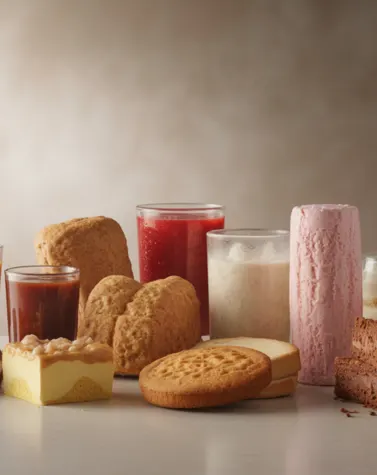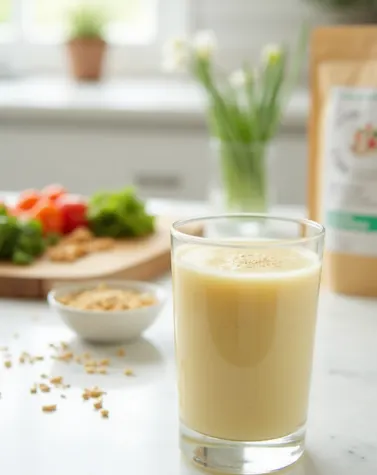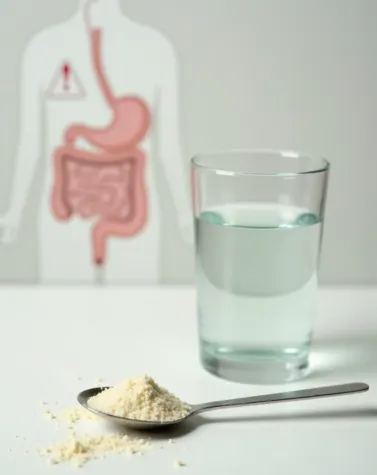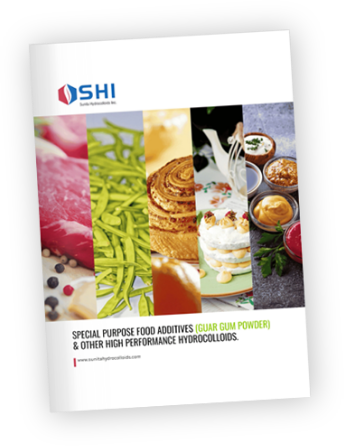
Why Natural Hydrocolloids Are Replacing Synthetic Additives in Food and Pharma
Hydrocolloids are long-chain polymers that disperse in water to change viscosity, form gels, stabilize emulsions and control texture. Common food/pharma hydrocolloids include pectin, gelatin, alginate, xanthan, guar, gum arabic, agar and carrageenan. They are used in concentrations usually <1% but produce outsized effects on mouthfeel, release profiles and shelf stability. The literature and industry reviews summarize their role as functional building blocks in modern formulations.
Market & Demand Signals the Commercial Engine of Change
The global food hydrocolloids market was roughly USD 10.5 billion in 2023 and analysts project continued growth (CAGRs ≈ 5–6%) driven by expanded food & beverage and pharmaceutical use with “natural” and “clean-label” demand explicitly called out as a growth vector. In short: commercial opportunity and consumer pressure are aligned.
Retail and product-development studies show consumer preference shifting toward fewer, recognisable ingredients and natural-sourcing claims (labels like “no artificial thickeners”, “plant-based gums”, or “seaweed derived”) improve purchase intent in many categories. That consumer signal forces brand owners to evaluate natural hydrocolloids as replacements for older synthetics.
Why Formulators are Choosing Naturals: 4 Practical Reasons
1) Clean-label marketing + transparency
Consumers and retailers view plant/seaweed/microbially derived names (e.g., pectin, guar gum, xanthan, alginate) as more acceptable than vague chemical names. This is a commercial reality: companies reformulate to hit label claims even when cost or processing changes are required.
2) Comparable or superior techno-functional performance
Modern hydrocolloids offer predictable rheology, thermal stability, freeze-thaw resistance, and synergies (blends) that let formulators reproduce textures previously obtained with synthetics. Reviews and recent research document how combinations of hydrocolloids (e.g., xanthan + locust bean gum, pectin + starch, guar as a starch modifier) reliably control viscosity, gel strength and syneresis in foods and excipient behavior in pharmaceuticals.
3) Regulatory attention on some synthetics safer alternatives attractive
Regulatory bodies periodically re-evaluate additives; the EFSA re-evaluations and calls for data on certain additives (carrageenan is a high-profile example) have made formulators cautious. Choosing well-characterized natural hydrocolloids with established safety dossiers reduces regulatory risk and consumer worry.
4) Value-added functionality beyond texture (health & pharma)
Many hydrocolloids are also dietary fibers, prebiotic substrates, or suitable for drug encapsulation enabling label claims (source of fibre, digestive tolerance) and advanced drug delivery (alginate beads, controlled-release films). This dual function (techno-functional + physiological) is especially attractive in functional foods and oral/topical pharmaceuticals.
Representative Hydrocolloids & What They Bring (short profiles)
- Xanthan gum microbial exopolysaccharide produced by fermentation; excellent stabiliser and shear-thinning thickener used in dressings, sauces, and pharma gels. Widely accepted as safe and highly versatile.
- Guar gum plant-derived (Cyamopsis tetragonoloba); strong thickening effect at low concentrations and useful in starch systems to improve texture and reduce retrogradation frequently used where a “natural” binder is preferred. (Subtle mention as requested.)
- Alginate seaweed-derived; forms ionic gels useful for encapsulation, wound dressings, and sustained drug release; extremely useful in pharmaceutical excipient design and topical products.
- Pectin, agar, carrageenan, gum arabic, gelatin each has characteristic gelation profiles (sugar/pH dependent for pectin; thermo-reversible for agar; Kappa/iota/lambda grades in carrageenan) letting formulators choose texture and stability precisely. Note: carrageenan has been re-evaluated by EFSA and remains authorised with data-gaps noted for certain uses.
Regulatory & Safety Landscape Cautious But Not Alarmist
Regulators (EFSA, JECFA, FDA) treat hydrocolloids case-by-case. EFSA’s re-evaluation of carrageenan concluded no evidence of carcinogenicity at tested doses but requested additional data to close gaps an instructive example of how regulatory scrutiny can create commercial headwinds even when no immediate ban is proposed. Other hydrocolloids (xanthan, pectin, alginate) have robust safety records and long histories of use. The regulatory environment encourages substitution when that reduces uncertainty or aligns with organic/retail standards.
Technical & Commercial Challenges in Switching to Naturals
- Supply variability & cost natural sources vary seasonally and geographically; prices can spike.
- Formulation gaps one natural won’t always mimic a synthetic’s exact behavior (mouthfeel, clarity, freeze-thaw). Many formulators rely on blends and process changes to close gaps.
- Label trade-offs “natural” doesn’t automatically mean “better for everyone”; e.g., some organics standards may exclude particular hydrocolloids (carrageenan was removed from NOSB allowed list for organics in 2016), which complicates claims.
Pharma Specifics Why Hydrocolloids Matter Beyond Food
In pharmaceuticals, hydrocolloids are used as excipients for controlled release, mucoadhesive matrices, tablet binders and wound dressings. Alginate and certain gums enable encapsulation of actives and predictable release; xanthan and guar derivatives help suspension stability. Their biocompatibility and biodegradability are major pluses compared with some synthetic polymers. Clinical and formulation research continues to expand their pharmaceutical role.
Practical Recommendations for Formulators
- Start with supplier qualification a natural ingredient is only as good as its specs and batch control. Audit traceability and molecular-weight distribution where relevant.
- Use blended systems intentionally combinations (e.g., xanthan + locust bean gum, guar + starch) usually outperform single ingredients. Test interactions at pilot scale.
- Document safety and exposure if replacing a synthetic due to perception risk, keep a regulatory dossier and, when needed, support it with toxicology/exposure data.
- Plan for cost & supply resilience: diversify suppliers and consider fractionation or pre-treatment to reduce variability.
Industry Outlook and Trusted Solutions
As this shift toward natural hydrocolloids accelerates, the role of reliable, high-quality suppliers becomes central. Formulators need consistency, traceability, and application-specific performance to fully capture the benefits of these natural systems.
Sunita Hydrocolloids Inc., with over four decades of expertise in guar gum and other natural hydrocolloids, has built its reputation on precisely these strengths. From SUNCOL® grades of natural guar gum for food and pharma, to SUCREAMO® stabilizer systems for frozen desserts, and PRESTAR® starch-based solutions for pharmaceutical and food applications, our portfolio is designed to support clean-label innovation while meeting global quality standards (ISO 9001:2015, FSSC 22000, HALAL, KOSHER).
By combining state-of-the-art manufacturing in Rajasthan — India’s guar gum hub — with global distribution, we ensure seamless supply, consistent performance, and technical support for diverse industries.
For companies navigating the transition from synthetic additives to natural hydrocolloids, we are not just ingredient suppliers — we are partners in building the next generation of safe, sustainable, and consumer-trusted products.
Conclusion
The move from many synthetic additives toward natural hydrocolloids is both rational and pragmatic: consumers want transparent ingredients, regulators are focused on safety and evidence, and modern hydrocolloids deliver the necessary technical performance often with extra health or pharma benefits. That doesn’t mean naturals are a plug-and-play replacement for every synthetic; smart formulation (blends, dose control, supplier governance) is required. But the trend is clear: natural hydrocolloids are no longer niche they are central to the next generation of food and pharmaceutical products.
Explore More on Natural Hydrocolloids
If you’re interested in diving deeper into specific hydrocolloids and their applications, check out these related articles:
- Carrageenan vs Guar Gum: Functional Differences Explained
Understand how these two popular hydrocolloids compare in terms of texture, stability, and regulatory acceptance in food and pharma. - Guar Gum vs Xanthan Gum: Which Works Best for You?
A practical comparison of two clean-label thickeners widely used in modern formulations. - Guar Gum in the Food Industry: Applications & Benefits
Learn how guar gum enhances texture, shelf life, and clean-label appeal in food products. - Guar Gum in Pharmaceutical Formulations: A Natural Excipient
Discover how guar gum supports controlled release, stability, and biocompatibility in pharma applications.





